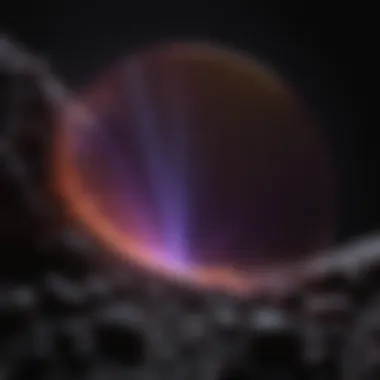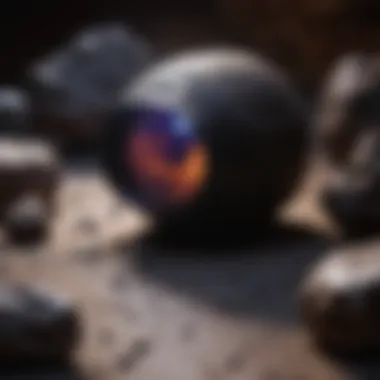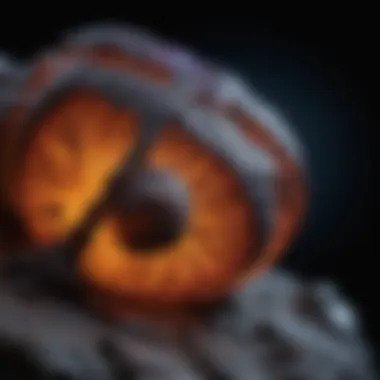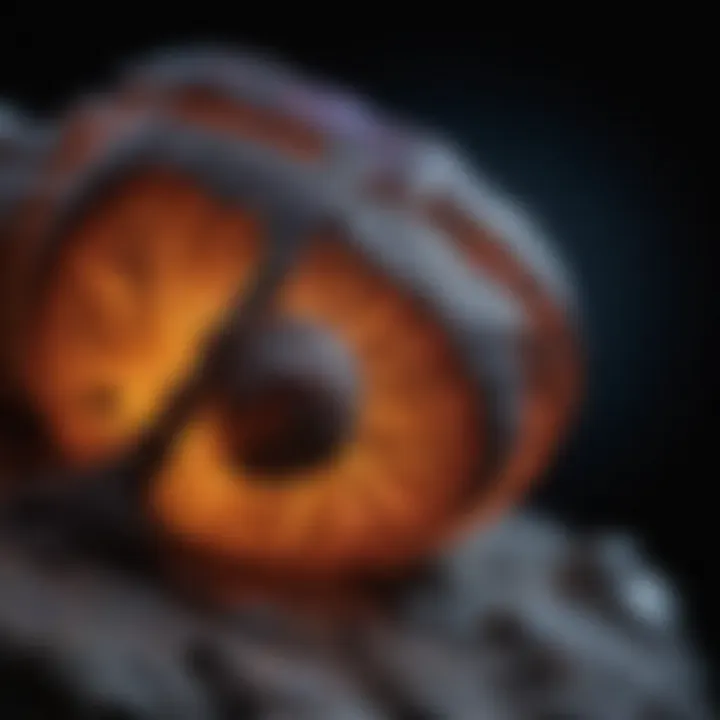Understanding Black Light and UV Light: Key Insights


Intro
Black light and ultraviolet (UV) light might sound like terms from a science fiction novel, but they are deeply embedded in our daily lives, lying just at the periphery of our visible experience. While we can’t see them directly, their effects are omnipresent and impactful, influencing various fields such as safety, forensics, and even the fine arts.
At first glance, these lights may seem to exist in a realm of novelty—often associated with psychedelic parties or the special effects of a thriller film. However, the underlying science and application of black light and UV light stretch far beyond mere entertainment. Their identity is shaped through their interaction with matter, particularly with different substances and biological systems, setting the stage for understanding their broader implications.
With this guide, we aim to explore the multifaceted nature of these light types, encompassing their principles, uses, and the often-overlooked significance in daily life. For rock and fossil collectors, a deeper understanding can enhance appreciation for the materials in play, revealing a hidden world made visible under black light.
This guide will examine crucial topics such as identification techniques for collectibles and the historical significance of items affected by UV light.
Let’s dive right in!
Preamble to Light
Light is everywhere, influencing how we perceive the world around us. But what exactly does light consist of, and how does it change our surroundings? Understanding light is vital to appreciating the nuances of black light and UV light. This section lays the groundwork for what follows, highlighting the unique properties that make these forms of light so intriguing.
The study of light is much more than a glance at the sun shining on a clear day. The complexities of light touch everything from scientific pursuits to art appreciation, bridging gaps across various disciplines. In investigating black light and UV light, we embark on a fascinating journey through the spectrum of electromagnetic waves.
Understanding Electromagnetic Spectrum
The electromagnetic spectrum is like a vast ocean filled with varying wavelengths, each carrying its own energy and properties. At one end are long, low-energy waves, while at the other are short, high-energy waves. This spectrum is not just a theoretical concept; it has practical implications in our daily life.
- Radio Waves: These waves have the longest wavelengths and are used in communication technologies like FM radio and TV.
- Microwaves: Shorter than radio waves, microwaves are commonly known for heating food.
- Infrared Light: Invisible to human eyes, infrared light is felt as heat, often associated with night vision technologies.
- Visible Light: This narrow band of the spectrum allows us to see our vibrant world, encompassing all the colors we know.
- Ultraviolet (UV) Light: Beyond visible light, UV light has shorter wavelengths and is responsible for processes like tanning and some types of sterilization.
- X-Rays and Gamma Rays: At the high-energy end, these are leveraged in medical imaging and cancer treatment.
Understanding this spectrum not only informs us about black light and UV light but also opens the door to appreciating their vast applications.
The Visible Spectrum vs. Invisible Light
It’s natural to think of light primarily in terms of what we can see, but invisible light plays just as crucial a role in the natural world. The visible spectrum represents a mere slice of the electromagnetic spectrum, and knowing the difference between visible and invisible light is crucial for embracing concepts like black light and UV radiation.
- Visible Light: This spectrum ranges from violet (the shortest wavelength visible to human eyes) to red (the longest). It is this light that allows us to enjoy a sunset or a blooming flower.
- Invisible Light: This category includes both UV light and infrared light. Although we cannot see it, invisible light has far-reaching implications, affecting everything from plant growth processes to safety protocols in various fields.
"Just because we can’t see it, doesn't mean it’s not there. Invisible light shapes our lives in profound ways".
In summary, a solid comprehension of light, whether visible or invisible, is paramount for anyone delving into the unique aspects of black light and UV light. This foundational knowledge sets the stage for a deeper exploration of their characteristics and applications.
Defining Black Light and UV Light
Understanding black light and UV light is essential, not only for scientific explorations but also for practical applications across various fields. By defining these two types of light, we pave the way to comprehend their unique characteristics, uses, and implications. Anyone involved in activities such as forensics, art conservation, or even rock and fossil collecting can greatly benefit from knowing how these lights function and interact with different materials. With a grasp of their distinctions, enthusiasts can enhance their appreciation and awareness in their respective areas.
Characteristics of Black Light
Black light, often referred to as ultraviolet light, is a type of light that is not visible to the human eye. It resonates within the UV spectrum specifically in the UVA range. What makes black light particularly fascinating is its ability to cause certain materials to fluoresce, or emit visible light when exposed to it. This phenomenon transforms ordinary settings into captivating visuals, as items such as minerals, paints, and unexpected surfaces reveal vibrant colors under its illumination.
In practical terms, black lights are widely used in various applications:
- Entertainment: Think of glow-in-the-dark parties or art displays. Artists often utilize black lights to make their work pop in dark environments.
- Safety and Security: Certain inks or substances only become visible under black light, aiding in identifying authenticity and preventing counterfeiting.
- Scientific Research: Researchers often employ black lights to investigate substances that react to UV light, unveiling hidden details in forensic science or biology.
In summary, the utility of black light stretches far beyond mere aesthetics. It serves multiple sectors, granting users a specialized tool for enhancing visibility and discovering new insights, particularly valuable for rock and fossil collectors.
Characteristics of UV Light
UV light, or ultraviolet light, has multiple categories, including UVA, UVB, and UVC, each characterized by its wavelength and impact on living organisms.
- UVA: Long-wave UV, this variant penetrates deep into the skin and is primarily connected with skin aging and development of skin cancers.
- UVB: Slightly shorter wavelengths that are responsible for tanning and sunburns; these can damage the skin's outer layer and contribute to more severe health risks.
- UVC: Often referred to as germicidal UV, this type is utilized for sterilization. It can scald the skin and is absorbed by the ozone layer.
The significance of UV light reaches far beyond just its visible counterpart. Its effects on living organisms have been extensively studied, revealing both beneficial and harmful implications. For instance, while UV light is germicidal and can eliminate harmful microbes, excessive exposure can lead to serious health problems, including skin issues and eye damage.
Thus, understanding the characteristics of UV light becomes essential, especially for collectors who may expose their specimens to such rays. Knowledge of the types can aid in seeking the optimal lighting conditions that showcase the beauty of their collections while safeguarding against damage that may lurk in unmeasured exposures.
"Knowledge of how black light and UV light operate is vital not merely for scientific inquiry but also for effective applications in everyday life."
Ultimately, whether for practical beaconing or the joys of illuminating hidden aspects, defining these light types opens up a vast landscape of explorative possibilities.
Types of UV Light


Understanding the different types of UV light is crucial, especially for those who delve into specific applications such as forensics, health care, or even art conservation. Each type of UV light – UVA, UVB, and UVC – comes with its unique properties and serves particular purposes. Not only does this knowledge inform safe practices, but it also enhances one's appreciation for how ultraviolet light influences various fields. From understanding the wavelength differences to recognizing their implications, this section aims to clarify the significance of each UV type.
UVA, UVB, and UVC: What Sets Them Apart
When considering UV light, one might wonder about the differences among UVA, UVB, and UVC. Each variation is defined by its wavelength, which influences its energy level and interactions with materials.
- UVA (315-400 nm): Often regarded as the “sunshine” UV, UVA penetrates deeply into the skin and is responsible for aging and long-term skin damage. It has a longer wavelength compared to the others, making it less intense but more prevalent during outdoor activities.
- UVB (280-315 nm): This type is primarily responsible for sunburns. It has more energy than UVA and can affect the skin's outer layers. It also plays a significant role in vitamin D synthesis. But exposure during peak hours can lead to burns and increase skin cancer risk.
- UVC (100-280 nm): UVC is the most harmful type; however, the earth's atmosphere absorbs it. Artificial sources like mercury lamps emit UVC, making it useful in sterilization processes. Its high energy ensures it can kill pathogens essential in medical and laboratory settings.
In essence, UVA rays are like that friend who overstays their welcome, causing subtle damage over time, while UVB is more like a sudden confrontation, burning you in the moment. On the other hand, UVC is akin to a strict guardian - highly effective but often kept at bay.
Applications of Each Type
The applications of UVA, UVB, and UVC extend into various realms, be it health care, industry, or even leisure. Let's break down how these distinct types of UV light are utilized:
- UVA Applications:
- UVB Applications:
- UVC Applications:
- Used in tanning beds, despite their long-term skin damage effects.
- Employed in phototherapy to treat skin conditions like psoriasis.
- Helpful in curing certain adhesives and inks due to their ability to penetrate.
- Utilized for vitamin D production in the skin - crucial for many bodily functions.
- Integral to certain medical treatments, specifically in phototherapy for skin disorders.
- Found in some types of fluorescent lights, enhancing visibility in specific contexts.
- Essential in sterilization, especially in hospitals and laboratories to eliminate pathogens.
- Important for water treatment processes, helping ensure safe drinking water.
- Used in air purification systems to eradicate airborne bacteria and viruses.
"Understanding the distinctive roles and applications of each UV type is pivotal for informed decisions regarding safety and application in various fields."
A deeper awareness of these types and their uses empowers rock and fossil collectors in making informed choices when handling and caring for specimens. Overall, knowledge of the types of UV light translates into safer practices and more effective applications in various aspects of both professional and personal life.
The Science Behind Black Light and UV Light
Understanding the science behind black light and UV light is crucial, not just for enthusiasts and collectors but also for various practical applications across different fields. This section addresses how black light and UV light operate, how they are emitted and detected, and their unique properties that make them fascinating. The significance of grasping these concepts lies in recognizing their benefits and implications. For instance, knowing how UV light can sterilize surfaces is vital for health professionals, while artists may find insights into how their materials react under black lights intriguing. These fundamentals shape our appreciation and understanding of light phenomena in our everyday lives.
Emitting and Detecting UV Light
When discussing emitting and detecting UV light, one has to delve into the technical aspects that govern this invisible spectrum. UV light, while not visible to the naked eye, can be emitted from various sources such as mercury vapor lamps, LEDs, and even the sun. The emitted light has a distinct wavelength range, typically between 10 nm to 400 nm.
Detecting UV light usually employs sensors and photodetectors that are responsive to its specific wavelengths. These devices can vary from simple UV meters to advanced imaging systems used in photography and scientific research. It’s essential to understand that not all UV light sources are created equal; the efficiency, intensity, and spectrum can vary significantly, which might impact their application or effectiveness.
Here are some key points about emitting and detecting UV light:
- Sources of UV Light: Different sources include sunlight, artificial lighting, and specialized equipment for specific applications.
- Detection Methods: UV light can be detected through photodiodes, photomultiplier tubes, or filters that isolate specific wavelengths for analysis.
- Potential Uses: Ranging from everyday safety checks to scientific research, recognizing the nuances of UV emission and detection is vital.
Mechanism of Fluorescence
Fluorescence is a captivating process that occurs when a substance absorbs UV light and then re-emits it, typically at a longer wavelength. This mechanism can be observed in various materials, such as certain minerals, dyes, and biological substances.
What’s fascinating about fluorescence is the transformation that occurs at the atomic level. The absorbed photons elevate electrons within an atom to a higher energy state. After a brief moment, these electrons return to their original state, releasing energy in the form of visible light. This phenomenon has significant implications, particularly for rock and fossil collectors, as certain specimens exhibit vibrant fluorescence under UV light. For instance, minerals like fluorite or calcite can glow with striking colors, revealing hidden beauty and characteristics that are otherwise undetectable under natural light.
It's no wonder many collectors invest in UV lights to enhance their collections.
To summarize the points about fluorescence:
- Ultraviolet Absorption: Many materials absorb UV light, which is key to the fluorescence effect.
- Energy Transition: The process involves basic quantum mechanics, where electrons transition between energy states.
- Applications in Collecting: Collectors utilize this phenomenon to identify and appreciate unique properties of minerals and fossils.
"Understanding the interplay between light and matter opens new avenues for appreciation and exploration in collecting."
In exploring the science behind these forms of light, enthusiasts can better appreciate their significance in both practical applications and aesthetic enjoyment.
Uses in Various Fields
The application of black light and UV light stretches across a wide array of fields, providing both practical benefits and innovative solutions. Understanding these uses is pivotal, especially for those interested in the interplay of science and everyday technologies. This section will illuminate how the properties of ultraviolet light can be advantageous in forensics, art conservation, and health protocols.
Forensics and Crime Scene Investigation
In the realm of forensics, UV light has become an integral tool for crime scene investigation. When applied, UV light can reveal vital evidence that might otherwise go unnoticed by the naked eye. What really sets it apart is its ability to enhance the visibility of substances like bodily fluids, fingerprints, and other trace evidence, which can be crucial in solving crimes. For instance, blood that may appear washed away under normal lighting can gleam under a UV lamp due to the fluorescence of proteins within it.
With the help of black lights, investigators can effectively:


- Detect hidden traces: Certain materials, like certain detergents or traces of drugs, may fluoresce when exposed to UV light.
- Enhance photographic evidence: Photographers in forensics often utilize UV light to capture images that reveal crucial details not visible to the naked eye.
Investigation techniques depend heavily on the science behind fluorescence. In this context, UV light doesn’t just aid in evidence collection; it substantially boosts the chances of connecting certain dots that may lead to a resolution in criminal cases.
"The application of UV light in forensics not only saves time but also significantly enhances the quality of evidence collected."
Art and Artifact Conservation
In the field of art and artifact conservation, black light serves a dual purpose of revealing the unseen as well as protecting valuable pieces. Art historians and conservators utilize UV light to assess the integrity of paintings and artifacts without causing any damage. When examined under black light, a myriad of features come to life. This includes restorations that have been made, which might otherwise blend seamlessly with the original artwork.
Some benefits include:
- Identification of previous repairs: Fluorescence can make past restoration efforts visible, allowing conservators to make more informed decisions about future work.
- Assessment of materials: Understanding the composition of paints and finishes can guide proper conservation techniques.
Furthermore, dealers and collectors benefit as well by having the means to confirm authenticity. In the world of art, where fakes can sometimes slip through the cracks, UV light plays the role of a vigilant guardian.
Health and Safety Protocols
The impact of UV light on health protocols cannot be understated. Particularly in recent times, UV-C light has gained traction in sterilization processes, proving to be an effective method for eliminating pathogens. The health sector leverages this technology in various settings, from hospitals to public transportation. Knowing that, it's not just beneficial but essential to maintain safety standards in environments where health risks loom.
Key points include:
- Disinfection of surfaces: UV-C light can eradicate bacteria and viruses on frequently touched surfaces.
- Air purification: Systems using UV light help in eliminating airborne pathogens, making public spaces safer.
In essence, the integration of UV light into health and safety protocols highlights not only a commitment to hygiene but also showcases innovation. It’s important for those in industries exposed to the public to recognize the value of these technologies in enhancing health safety standards.
The Impact of UV Light on Biological Systems
Understanding the impact of ultraviolet (UV) light on biological systems is essential to grasp the wider implications of UV exposure in various contexts. UV light operates beyond the visible spectrum, providing both benefits and challenges in health and ecological dynamics. Over the years, there have been significant discussions surrounding its dual role as both a potential health risk and a necessary component of life. Given its pervasiveness in the environment, especially in sunlight, the consequences of UV light touch numerous aspects of our world.
Effects on Human Health
UV light, particularly in the form of UVA and UVB radiation, can lead to a variety of health outcomes for humans. While some exposure is beneficial—such as the synthesis of vitamin D—overexposure can result in several adverse effects. Skin damage is perhaps the most recognized consequence, which includes sunburn, accelerated aging, and even skin cancer, predominantly associated with cumulative UV exposure over time.
The physiological responses to UV light often cause skin cells to react with defense mechanisms, leading to inflammatory responses. This reaction can range from mild irritation to more severe conditions such as actinic keratosis, which is a precancerous skin condition. Different skin types respond distinctively to UV exposure, with those possessing lighter skin being more susceptible to damage.
"Moderation is key. Limited exposure can be your friend, but too much can be a foe."
Maintaining awareness of exposure limits is crucial. Using protective clothing, sunscreen, and seeking shade can mitigate risks significantly. Moreover, regular dermatological check-ups can help catch any adverse effects early. Education surrounding safe UV exposure practices is necessary as we embrace outdoor activities and as the ozone layer continues to fluctuate, leading to increased UV levels reaching the Earth’s surface.
Implications for Ecosystems
UV light's role in ecosystems is a double-edged sword. While it can potentially harm young aquatic organisms and disrupt food webs, it also plays a critical role in regulating processes essential for ecological balance. For instance, sufficient UV exposure helps to support the growth and reproduction of phytoplankton, a cornerstone of aquatic food webs. The fluctuation of UV radiation can impact species composition, including the various plants and animals competing for resources in ocean waters.
Moreover, the influence of UV light extends to terrestrial ecosystems too. Plants utilize UV light as a cue for growth, influencing photosynthetic rates and flowering times. However, too much UV exposure can hinder plant growth, leading to changes in the habitat that affect countless species dependent on vegetation for food and shelter.
Additionally, UV radiation can impact microbial communities in soil, which in turn affects nutrient cycling and soil health. The implications trickle down through the food chain, influencing various species including herbivores and predators.
In summary, UV light is essential for many biological processes, yet excessive exposure poses significant risks to health and ecosystems. Moving forward, a balanced understanding of UV light's benefits and dangers will be crucial for safeguarding both human health and natural ecosystems.
Exploring Commercial Uses
The realm of black light and UV light holds significant promise across various industries. Understanding these technologies isn't just for scientific curiosity; it has practical implications that can enhance consumer experience and health protection. Below, we delve deeper into two primary avenues where these lights are not only indispensable but also transform the way we perceive our environment.
Black Lights in Entertainment
Black lights have carved a niche in the entertainment industry, influencing how audiences interact with performances. From nightclubs to theatrical productions, the usage of black lights creates an electrifying atmosphere. They work by emitting ultraviolet light that makes certain materials glow, creating vivid, eye-catching effects that enhance visual storytelling.
- Vibrant Experiences: Many entertainment venues utilize black lights to intensify colors, making fluorescent objects pop. This not only attracts viewers but also elevates the entire ambiance.
- Applications in Events: For events like weddings or birthdays, black lights can create an extraordinary theme. Decorations and attire designed with fluorescent paints or materials respond to UV light, turning ordinary spaces into whimsical realms.
- Impact on Art and Performance: Artists often use black light to accentuate their work. Paintings and sculptures specifically designed for UV light can elicit a unique feedback from the audience. The interplay of light and shadow adds depth that isn't possible with regular illumination.
Thus, the incorporation of black lights into entertainment highlights the symbiotic relationship between technology and creativity, enhancing not just experience but also safety during certain events like Halloween where reflective costumes draw attention.
UV-C in Sterilization Technologies
In recent years, the significance of UV-C light as a sterilization tool has surged, especially in the context of public health. Its capability to deactivate pathogens has made it a go-to solution in industries ranging from healthcare to food safety.


- Microbial Control: UV-C light works on a fundamental level by destroying the DNA of bacteria and viruses. This is not only crucial for healthcare facilities but also for various commercial settings such as restaurants and laboratories, ensuring a higher standard of hygiene.
- Air and Surface Purification: Upon integration into HVAC systems, UV-C technology can assist in purifying the air, reducing the spread of airborne diseases. It also provides effective surface sterilization in environments that require stringent cleanliness, such as clinics and food processing plants.
- Cost-Effective and Sustainable: Utilizing UV-C systems can lead to cost savings when it comes to long-term sanitizing strategies. By minimizing the need for harsh chemical disinfections, businesses can foster a greener approach, which is becoming increasingly significant to modern consumers.
In summary, the role of UV-C in sterilization isn't merely a trend; it’s a vital component in safeguarding health and enhancing safety protocols in commercial applications. Underlined by the recent global health concerns, its relevance cannot be overstated.
"In an era where cleanliness is closely monitored, incorporating UV light solutions serves both a hygienic and a marketing edge for businesses."
Regulations and Safety Guidelines
In the realm of black light and UV light, regulations and safety guidelines serve as a cornerstone for safeguarding both users and the environment. Understanding these guidelines is essential for anyone working with these types of light, especially in fields where exposure is frequent or prolonged. They help to protect individuals from potential harm, be it from UV radiation's adverse health effects or the implications it might have on materials and ecosystems. Compliance not only ensures safety but also aligns practices with industry standards, fostering responsible usage.
Understanding UV Exposure Limits
When it comes to ultraviolet (UV) light, exposure limits are crucial. These limits are set to minimize health risks associated with UV radiation. Various organizations, such as the International Commission on Non-Ionizing Radiation Protection (ICNIRP) and the Occupational Safety and Health Administration (OSHA), provide guidelines on acceptable exposure levels. For instance, UVB rays can lead to skin burns and increase the risk of skin cancer, while UVA rays penetrate deeper, potentially damaging the skin at a cellular level.
For hobbyists and professionals alike, it’s vital to recognize the symptoms of overexposure. This can include redness, swelling, or peeling skin, similar to sunburn. A key takeaway is that prolonged exposure should be avoided, and one should always be aware of their surroundings when working with devices emitting UV light.
Best Practices for Safe Usage
To ensure safe usage of black light and UV light, a number of best practices can be adopted. Here are some essential guidelines:
- Personal Protective Equipment (PPE): Always wear appropriate goggles to protect your eyes from UV exposure, and consider shielding skin with clothing or sunscreen.
- Workspace Considerations: Set up work areas in a way that minimizes direct exposure, using barriers or shields to block stray light.
- Monitoring Equipment: Utilize UV radiation meters to gauge levels of exposure, ensuring they remain below recommended limits.
- Education and Training: Engage in training sessions to stay updated on safe usage practices and the latest safety equipment.
- Emergency Procedures: Know the protocol in case of an overexposure incident. This could include seeking medical attention promptly and reporting the situation to the relevant safety officer.
"A mind is a terrible thing to waste, and skin is a terrible thing to damage." Take this to heart when working with UV light.
By adhering to these guidelines, individuals can navigate the fascinating applications of black light and UV light while keeping safety as a top priority. Considering the intricate balance between usage and protection can help cultivate a safer environment for both enthusiasts and professionals.
Future Developments in UV Technology
The world of ultraviolet light is not static. Progress in technology continually shapes its applications, adapting to meet modern needs and concerns. Thinking about future developments in UV technology brings to mind endless possibilities. This section explores how advancements can transform various sectors, bringing both benefits and considerations, especially in fields pertinent to rock and fossil collectors.
Advancements in UV Light Applications
The advancements in UV light applications are almost akin to magic tricks—each round of improvements uncovers a new layer of utility that was hidden before. For instance, in the realms of public health, the utilization of UV-C light for sterilization is gaining ground. The recent pandemic underscored its effectiveness against pathogens. Here’s how it can matter:
- Health Safety: Businesses, schools, and public facilities are implementing UV light systems to ensure safer environments. For rock and fossil collectors, this means enhanced safety when examining specimens, particularly those retrieved from potentially hazardous environments.
- Environmental Monitoring: New sensors using UV technology can detect pollutants. This can help collectors determine the purity and environmental history of the rocks and fossils they cherish.
- Digital Imaging: Developing UV imaging techniques can reveal details hidden to the naked eye. This is particularly beneficial when examining delicate fossils or rare minerals, potentially leading to new discoveries.
As scientists explore the potential of nanotechnology in UV applications, we can expect even subtler methods for cleaning and examining fossils without damaging the material. Interested individuals can read more about this on platforms like Wikipedia.
Challenges and Opportunities
While the sky is the limit with UV technology advancements, hurdles need addressing. Here are several challenges along with the opportunities they present:
- Regulatory Hurdles: The introduction of new UV applications often faces scrutiny from regulatory agencies. This is particularly true in its health-related uses. Compliance with safety standards can delay innovations. However, this also presents an opportunity for researchers to refine safety practices, leading to better solutions down the line.
- Cost of Implementation: New technologies require significant capital investment. Smaller businesses or collectors may find adapting to these changes financially burdensome. Innovative financing models or community-based initiatives could mitigate these costs, making cutting-edge UV technology accessible to all.
- Public Awareness: The potential of UV technologies isn't always well understood by the public. There’s a need for educational programs to highlight the benefits and safety of UV lights, especially in niche fields. This can be an opening for those passionate about geology or paleontology to educate others and advocate for more widespread acceptance.
The future of UV technology holds immense potential, particularly in ensuring the ongoing safety and conservation of rock and fossil specimens. As these developments unfold, they may change not only how collectors engage with their materials but also how societies approach health and environmental challenges.
End: Reflecting on the Importance of Light
As we draw the curtains on our exploration into black light and UV light, it’s prudent to take a step back and consider the profound implications these wavelengths hold in multiple domains. Light, especially in its ultraviolet form, is a key player in both nature and technology, serving as a bridge to understanding phenomena that permeate our daily lives.
The significance of this discussion is underscored by its impact on various fields such as health, forensics, art preservation, and industrial applications. Each of these areas benefits from an appreciation of how UV light can unveil truths, enhance safety protocols, and protect valuable artifacts. The capacity of UV technology to expedite processes like sterilization speaks volumes from a public health perspective—especially in recent times, when pathogens are under constant scrutiny.
This conclusion also highlights a few considerations regarding our relationship with light:
- Health Awareness: The dual nature of UV light presents both opportunity and risk. While it can be harnessed for beneficial purposes, such as medical sterilization or creating immersive experiences in entertainment, it also poses potential harm. Awareness of UV exposure limits is crucial to safeguard against its effects.
- Conservation Efforts: In the realm of art and antiquities, understanding how different light spectrums interact with materials is essential. Preventive conservation efforts hinge on effective light management, ensuring that cultural heritage is preserved for future generations.
In essence, by recognizing the importance of light in its various forms, we can enhance our appreciation of not only technological advancements but also the natural world around us. The nuances in how light functions demand our attention, especially as our understanding continues to evolve.
Summary of Key Insights
Throughout this exploration, we have covered several pivotal insights about black light and UV light:
- Diversity of UV Light: UV light is categorized into three main types—UVA, UVB, and UVC—each possessing distinct characteristics and applications. Their varied effects range from beneficial to harmful, underlining the necessity for nuanced comprehension.
- Applications Across Fields: Whether in crime scene investigation aiding forensics, or in sterilization applications in healthcare, the practical uses of UV light demonstrate its versatility and significance.
- Regulatory Measures: Understanding exposure limits and safety practices is crucial not only for professionals using UV technology but also for everyday individuals who encounter these lights in various settings.
Encouragement for Further Exploration
As we conclude, it’s essential to inspire further inquiry into the captivating world of ultraviolet light. For enthusiasts, collectors, or anyone intrigued by the unseen worlds illuminated by black light, here are a few paths for future exploration:
- Scientific Research: Delve into the ongoing research around UV light applications, particularly in innovative fields like photobiology and materials science.
- Art and Culture: Investigate the intersection of UV light and art by studying artists and institutions that use black light in their work. This journey can reveal striking insights into how light affects perception and experience.
- Personal Safety Practices: Stay proactive in learning about safety measures when working or playing in environments that utilize UV technology, ensuring a balanced appreciation of benefits and risks.
Ultimately, light, whether seen or unseen, is a subject worthy of our curiosity. Embrace the journey of discovery that lies ahead, and let your fascination with black light and UV light continue to unfold.



